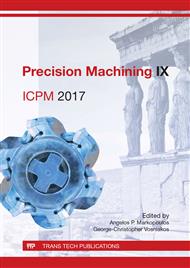[1]
T.C. Paul, A.K.M.M. Morshed, E.B. Fox, A.E. Visser, N.J. Bridges, J.A. Khan, Buoyancy driven heat transfer behavior of [C4mim][NTf2] ionic liquid: an experimental study, Appl. Therm. Eng. 66 (2014) 534–540.
DOI: 10.1016/j.applthermaleng.2014.02.047
Google Scholar
[2]
T. Welton, Room-temperature ionic liquids: solvents for synthesis and catalysis, Chem. Rev. 99 (1999) 2071–(2083).
DOI: 10.1021/cr980032t
Google Scholar
[3]
H.L. Ngo, K. LeCompte, L. Hargens, A.B. McEwen, Thermal properties of imidazolium ionic liquids, Thermochim. Acta 357–358 (2000) 97–102.
DOI: 10.1016/s0040-6031(00)00373-7
Google Scholar
[4]
F. Endres, S.Z. El Abedin, Air and water stable ionic liquids in physical chemistry, Phys. Chem. Chem. Phys. 8 (2006) 2101–2116.
DOI: 10.1039/b600519p
Google Scholar
[5]
E.B. Fox, A.E. Visser, N.J. Bridges, J.W. Amoroso, Thermophysical properties of nanoparticle-enhanced ionic liquids (NEILs) heat-transfer fluids, Energy Fuels 27 (6) (2013) 3385–3393.
DOI: 10.1021/ef4002617
Google Scholar
[6]
N.J. Bridges, A.E. Visser, E.B. Fox, Potential of nanoparticle-enhanced ionic liquids (NEILs) as advanced heat-transfer fluids, Energy Fuels 25 (10) (2011) 4862–4864.
DOI: 10.1021/ef2012084
Google Scholar
[7]
T.C. Paul, A.K.M.M. Morshed, E.B. Fox, J.A. Khan, Thermal performance of Al2O3 Nanoparticle Enhanced Ionic Liquids (NEILs) for Concentrated Solar Power (CSP) applications, Int. J. Heat Mass Transfer 85 (2015) 585–594.
DOI: 10.1016/j.ijheatmasstransfer.2015.01.071
Google Scholar
[8]
T.C. Paul, A.K.M.M. Morshed, E.B. Fox, J.A. Khan, Experimental investigation of natural convection heat transfer of Al2O3 Nanoparticle Enhanced Ionic Liquids (NEILs), Int. J. Heat Mass Transfer 83 (2015) 753–761.
DOI: 10.1016/j.ijheatmasstransfer.2014.12.067
Google Scholar
[9]
C.A. Nieto de Castro, M.J.V. Lourenco, A.P.C. Ribeiro, E. Langa, S.I.C. Vieira, Thermal properties of ionic liquids and ionanofluids of imidazolium and pyrrolidinium liquids, J. Chem. Eng. Data 55 (2010) 653–661.
DOI: 10.1021/je900648p
Google Scholar
[10]
F. Wang, L. Han, Z. Zhang, X. Fang, J. Shi, W. Ma, Surfactant-free ionic liquid based nanofluids with remarkable thermal conductivity enhancement at very low loading of graphene, Nanoscale Res. Lett. 7 (2012) 314.
DOI: 10.1186/1556-276x-7-314
Google Scholar
[11]
A. Menbari, A.A. Alemrajabi, A. Rezaei, Heat transfer analysis and the effect of CuO/water nanofluid on direct absorption concentrating solar collector, Appl. Therm. Eng. 104 (2016) 176–183.
DOI: 10.1016/j.applthermaleng.2016.05.064
Google Scholar
[12]
C.A. Nieto de Castro, S.M. Sohel Murshed, M.J.V. Lourenço, F.J.V. Santos, M.L. Matos Lopes and J.M.P. França, Ionanofluids– new heat transfer fluids for green processes development, Green Solvents I: Properties and Applications in Chemistry, Springer Netherlands, (2012).
DOI: 10.1007/978-94-007-1712-1_8
Google Scholar
[13]
SUS Choi, Z Zhang, W. Yu, F. Lockwood, E. Grulke, Anomalous thermal conductivity enhancement in nanotube suspensions. Appl Phys Lett, 79 (2001) 2252-2254.
DOI: 10.1063/1.1408272
Google Scholar
[14]
Ding Y, Alias H, Wen D, Williams RA (2006) Heat transfer of aqueous suspensions of carbon nanotubes (CNT nanofluids). Int J Heat Mass Transfer, 49 (2006) 240-250.
DOI: 10.1016/j.ijheatmasstransfer.2005.07.009
Google Scholar
[15]
H Xie, H Lee, W Youn, M Choi, Nanofluids containing multiwalled carbon nanotubes and their enhanced thermal conductivities. J Appl Phys, 94 (2003) 4967-4971.
DOI: 10.1063/1.1613374
Google Scholar
[16]
A. Amrollahi, AM Rashidi, MM Emani, K Kashefi, Conduction heat transfer characteristics and dispersion behaviour of carbon nanofluids as a function of different parameters, J Exp Nanosci 4 (2009) 347-363.
DOI: 10.1080/17458080902929929
Google Scholar
[17]
G. Żyła, J. Fal, P. Estellé, The influence of ash content on thermophysical properties of ethylene glycol based graphite/diamonds mixture nanofluids, Diamond & Related Materials, doi: 10. 1016/j. diamond. 2017. 02. 008 (2017).
DOI: 10.1016/j.diamond.2017.02.008
Google Scholar
[18]
G. Żyła, Viscosity and thermal conductivity of MgO-EG nanofluids: experimental results and theoretical models predictions, Journal of Thermal Analysis and Calorimetry, doi: 10. 1007/s10973-017-6130-x (2017).
DOI: 10.1007/s10973-017-6130-x
Google Scholar
[19]
G. Żyła, J. Fal, Viscosity, thermal and electrical conductivity of silicon dioxide – ethylene glycol transparent nanofluids: An experimental studies, Thermochimica Acta, 650 (2017) 106–113.
DOI: 10.1016/j.tca.2017.02.001
Google Scholar


